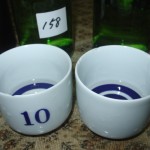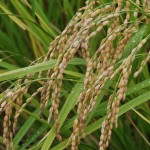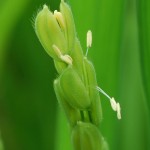Now, that’s using your head!
 Long before the days of thermometers, hydrometers and barometers, brewers relied entirely on their senses to gauge the progress of a fermenting tank of sake. They might not have known the scientific causes, but experience and intuition told them how to interpret what they saw, tasted and smelled.
Long before the days of thermometers, hydrometers and barometers, brewers relied entirely on their senses to gauge the progress of a fermenting tank of sake. They might not have known the scientific causes, but experience and intuition told them how to interpret what they saw, tasted and smelled.
One of the most reliable of these empirical yardsticks — one that is still used today — is the appearance of foam on the top of the moromi (fermenting mash). Throughout the 18- to 35-day ferment, the foam will change appearance quite regularly — and very clearly reflect what is taking place inside the tank. Over the centuries, names were given to the foam at each stage, making it easy to assess and convey the status of the work in progress.
After the yeast starter has been created, and after water, rice and koji have been added over four days, foam will begin to develop as the yeast cells process the sugars in the tank and give off carbon dioxide. This will rise to the surface, often dragging yeast cells with it. This is why the foam has 2 1/2 times as many yeast cells in it as the liquid beneath.
Two or three days into the ferment, small striations will appear on the surface, similar to taut muscle under skin; hence the term suji-awa (muscle foam). Next, a thick layer of soft foam will begin to cover the entire tank; this is known as mizu-awa (water foam).
The timing of these changes, of course, depends on myriad factors, such as how much the rice has been milled or the tank’s temperature. But soon after this, the ferment will enter its most active stage, and foam will rise in great swaths, so that it looks like huge boulders tumbling over each other. This is known as iwa-awa (rock foam).
This continues into the highest stage of foam, known as taka-awa, when the bubbles themselves become very small and fine. This usually occurs around the 10th day or so, but there is great variation.
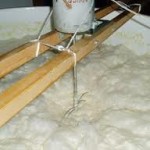 The foam rises so high that brewers usually use a simple rig consisting of a piece of wire that gently spins on a motor. Its sole purpose is to beat down the foam gradually, which spares them the need for high-walled tanks. It also aids in sanitation, as one of the greatest sources of sake-spoiling bacteria is foam that has dried on the tank’s interior.
The foam rises so high that brewers usually use a simple rig consisting of a piece of wire that gently spins on a motor. Its sole purpose is to beat down the foam gradually, which spares them the need for high-walled tanks. It also aids in sanitation, as one of the greatest sources of sake-spoiling bacteria is foam that has dried on the tank’s interior.
As the fermentation begins to wane, the foam too falls back, leading to the stage known as ochi-awa (falling foam). This segues into a stage with very large, soapy-looking bubbles known as tama-awa (ball foam).
After this foam also fades away, the moromi’s surface is referred to as ji (ground). This stage has many sub-conditions with their own names. Small wrinkles in the surface are referred to as chiri-men (a type of rough cloth). A totally smooth surface is known as bozu, in reference to the shaved head of a priest. If rice solids that did not ferment have risen to the surface, it may look like a lid is on the moromi, and this is referred to as futa (lid).
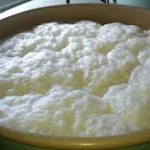 Much can be told about the quality of the sake at this stage from observing this surface. For example, if the lid is thick, it indicates that a significant amount of wild yeast ended up in the moromi and survived. This is because the rice fibers tend to attach themselves to many types of wild yeast and rise to the surface when pulled by the carbon dioxide molecules, giving that thick-lidded appearance. Brewers know, then, that a thick-lidded moromi in its final stages will often lead to a sake that is rough, acidic and less refined.
Much can be told about the quality of the sake at this stage from observing this surface. For example, if the lid is thick, it indicates that a significant amount of wild yeast ended up in the moromi and survived. This is because the rice fibers tend to attach themselves to many types of wild yeast and rise to the surface when pulled by the carbon dioxide molecules, giving that thick-lidded appearance. Brewers know, then, that a thick-lidded moromi in its final stages will often lead to a sake that is rough, acidic and less refined.
Naturally, today these observations are combined with chemical measurements, such as acidity, residual sugar and temperature, to create the precise and wonderful flavor profiles.
Note, there are yeast strains that do not foam up, which has several advantages, including permitting brewers to get higher yields out of their tanks, since they do not have to worry about leaving room for the rising foam. Let us look at these non-foaming yeasts in more depth in the near future.
~~~~~~~~~~~~~~~~~~~~~~~~~~~~~~~~~~~~~~~~~~~~~~~~~~~~~~~~~~~~
Sake Professional Course Sake Pro Course NYC 2013
Kikizake-joko – Official Tasting Glasses
Dallas, Texas, August 8~10, 2013
The next Sake Professional Course will take place August 8-10, in conjunction with TEXSOM 2013 at the Four Seasons Resort and Club Dallas at Las Colinas in Irving, Texas
More about the seminar, its content and day-to-day schedule, can be found here:
http://www.sake-world.com/html/spc_texsom_2013.html
The Sake Professional Course, with Sake Education Council-recognized Certified Sake Professional certification testing, is by far the most intensive, immersing, comprehensive sake educational program in existence. The three-day seminar leaves “no sake stone unturned.”
The tuition for the course is $825. Feel free to contact me directly at sakeguy@gol.com with any questions about the course, or to make a reservation.





